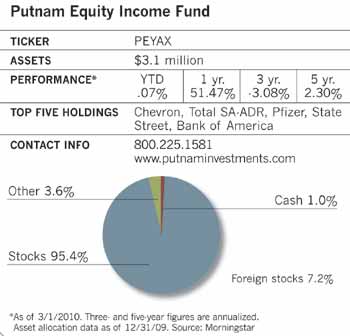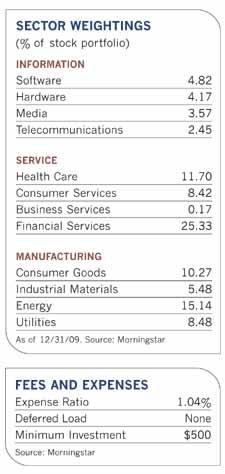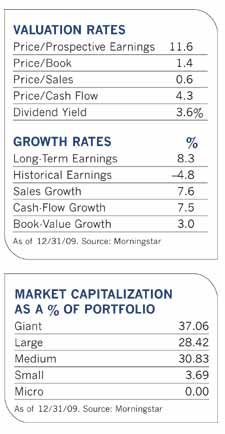As the manager of a stock fund with more than $3 billion in assets, Bart Geer is not the kind of shopper you would expect to see wandering the aisles at Big Lots, a retailer known more for closeout prices than high-end clientele. But Geer, who has managed the 33-year-old Putnam Equity Income fund for almost a decade, figures that investing in the stock of Big Lots is a great way to capitalize on his expectations for a continuing economic recovery.
The retailer generates lots of cash and keeps a tight rein on costs, which allows it to squeeze out maximum earnings from every dollar of sales. Those earnings should exceed analyst expectations as the economy gains steam and sales perk up. And the stock, selling at 11 times estimated earnings, represents a solid value.
Then there's the powerful draw of the deal. "Big Lots has a loyal customer base of bargain hunters who will go out of their way to visit stores," says Geer. "Its aggressive pricing across lots of different products persuades people to change their shopping behavior." Those customers pushed retail sales for the company's most recent fiscal quarter up 6.9% over the previous year.
In Geer's view, companies with ample cash flow such as Big Lots that can take advantage of a broadening economic recovery and exceed analysts' earnings projections will be this year's market leaders.
By contrast, fire-sale price stocks led during last year's rally, including battered banks. Geer showed his contrarian side in early 2009 when he established positions in then-unpopular banks such as Wells Fargo, Bank of America and State Street Corporation. He added the last company in January after credit agencies downgraded its debt and investors cut the stock price in half. Geer felt that State Street, as one of the world's largest security custodians, was being punished too severely and would remain profitable. But the company's stock rose sharply during the year, along with other financial names that benefited from the ebbing of panic in the financial system, and helped his fund beat its benchmark, the Russell 1000 Value Index, by 7.5%.
With last year's rebound rally behind him, Geer is turning his attention to cyclical recovery plays. He sees evidence of economic recovery on a number of fronts-in positive earnings trends and in the large number of companies exceeding analyst estimates. "Cash flow margins are near all-time highs, which is extraordinary given that the bulk of the economic recovery has not even kicked in yet," he says. "Companies have generally done a good job of managing through the downturn."
He expects the stock market to deliver positive returns for the year as earnings catch up with higher stock prices, though a repetition of last year's bounty is unlikely. "Valuations are obviously not as cheap as they were last year, but they are still relatively attractive," he says.
But periodic bad news continues to overshadow positive trends. At the beginning of the year, stocks plunged on reports of government efforts in China to head off inflation through lending constraints. More recently, high employment and slow recoveries in Greece, Spain and Portugal have raised concerns about the prospects for European markets.
Geer believes that while those southern European countries will continue to lag other world economies, most countries in Europe remain on firmer ground and will continue to step in to help steady the financial health of their poorer neighbors and reassure investors. "My view is that we're primarily domestic investors, and these issues are not central to the U.S. economy."
In this country, he sees signs of stability in the housing market as excess inventories diminish and demand catches up with supply. The commercial construction industry, while still sharply curtailed, should still work through its indigestion over the next year or two.
"Both housing and auto industries have passed their worst points," he says. "More importantly for investors, the market has already heavily discounted those stocks."
For those reasons, the 54-year-old manager has been increasing his allocation to cyclical stocks such as TRW Auto, which produces safety products such as seat belts and air bags, as well as engine components and replacement parts. While concerns about the auto industry have held the stock back, Geer believes things will change as automobile sales pick up and profits improve. What's more, TRW, priced at 10 times estimated earnings, is a bargain.
Geer tries to keep his options open as much as he can without straying too far from the fund's mandate of large and midsize value companies. One fund requirement is that companies must have a dividend yield that exceeds that of the benchmark Russell 1000 Value Index, or sell cheaply relative to the index based on price-to-book, price-to-sales and price-to-earnings ratios. He generally tries to stay within 600 basis points of the index's sector weighting to avoid a large tracking error.
But there is also room for manager discretion in this widely dispersed portfolio of 100 to 125 securities. Geer doesn't adhere to a strict set of financial criteria, and he believes the metrics of a good company differ from sector to sector. Some stocks may be traditional value holdings, while others, such as those in the technology sector, have more growth characteristics. He often ventures outside the benchmark universe to find stocks, or he overweights or underweights stocks in the index to align with his views about their financial strength and prospects for earnings growth. The fund depends on lots of small wins, rather than one or two large macro calls or security bets, to stay ahead of its benchmark. It has usually managed to do that, according to Morningstar analyst Jonathan Rahbar, who notes in a report that "Geer's dynamic research process and solid track record for making good calls without courting a lot of risk make this fund a great option."
Despite Putnam Equity Income's name, income is not the fund's primary focus. Most of the holdings may pay dividends, but Geer sees these dividends as evidence of the companies' financial stability and shareholder friendliness rather than an investment end in themselves. "Sectors such as utilities, REITs and banks that pay high dividends are riskier than many people believe and have suffered severe downturns in recent years," he says. "With more companies offering or increasing dividends as the economy recovers, there are better alternatives now among companies that offer somewhat lower dividends but have better prospects for growth."
Electric utilities are underweight in his fund relative to the benchmark, mainly because Geer sees better prospects for growth elsewhere (the exception being AES Corporation, a global power company that operates in 30 countries and has several new projects in the pipeline that could bring revenue growth in 2010). He has also pared his fund's positions in consumer staples companies such as Energizer Holdings and Proctor & Gamble because of his concerns about pricing competition.
At nearly 25% of the fund's assets, financials are its largest sector component, though Geer sold some banking stocks after last year's sharp rebound. The industry still faces significant risks, but Geer feels that the market has already discounted the stocks quite heavily. Some of the companies will be able to retain value for shareholders by selling or spinning off parts of their businesses. Later in the year, he believes, some banks may even increase their dividends. "This is a really cheap area of the market that everyone hates, but it looks like it's reaching a contrarian bottom," he says.
The financial sector also includes property and casualty companies such as PartnerRe, which has an attractive dividend yield and sells at just eight times earnings. He views the property and casualty sector as "inexpensive based on virtually any metric" and less risky than life insurers, banks or brokerage firms.
One of last year's underperformers was Lockheed Martin Corporation, whose high pension expenses triggered a fall in its stock price. It remains in the portfolio, since Geer believes the stock is attractively valued and provides a respectable yield. Other disappointments included energy companies Total S.A., British Petroleum and ExxonMobil. While the first two remain in the portfolio, Geer sold the last one late last year when its performance lagged others in the group.
This year, the fund is underweight relative to the index in energy stocks. Geer believes oil prices could drop later in the year as demand comes in below expectations and rising extraction costs constrain free cash flow. New reserves opening up in Africa and Brazil, as well as possible production increases in a postwar Iraq, could increase oil supplies and subdue prices.
Health care is the fund's largest overweight sector, with holdings concentrated in pharmaceuticals such as Pfizer, Johnson & Johnson and Abbott Laboratories. Despite solid balance sheets and health dividend yields, many health care stocks lagged the market last year because of the concerns over health care reform and patent expirations. Geer is surprised that the stocks have not rebounded as concerns over reform ease; he likes their attractive prices and stable cash flows, and he believes the stocks "are beginning to find a bottom."



